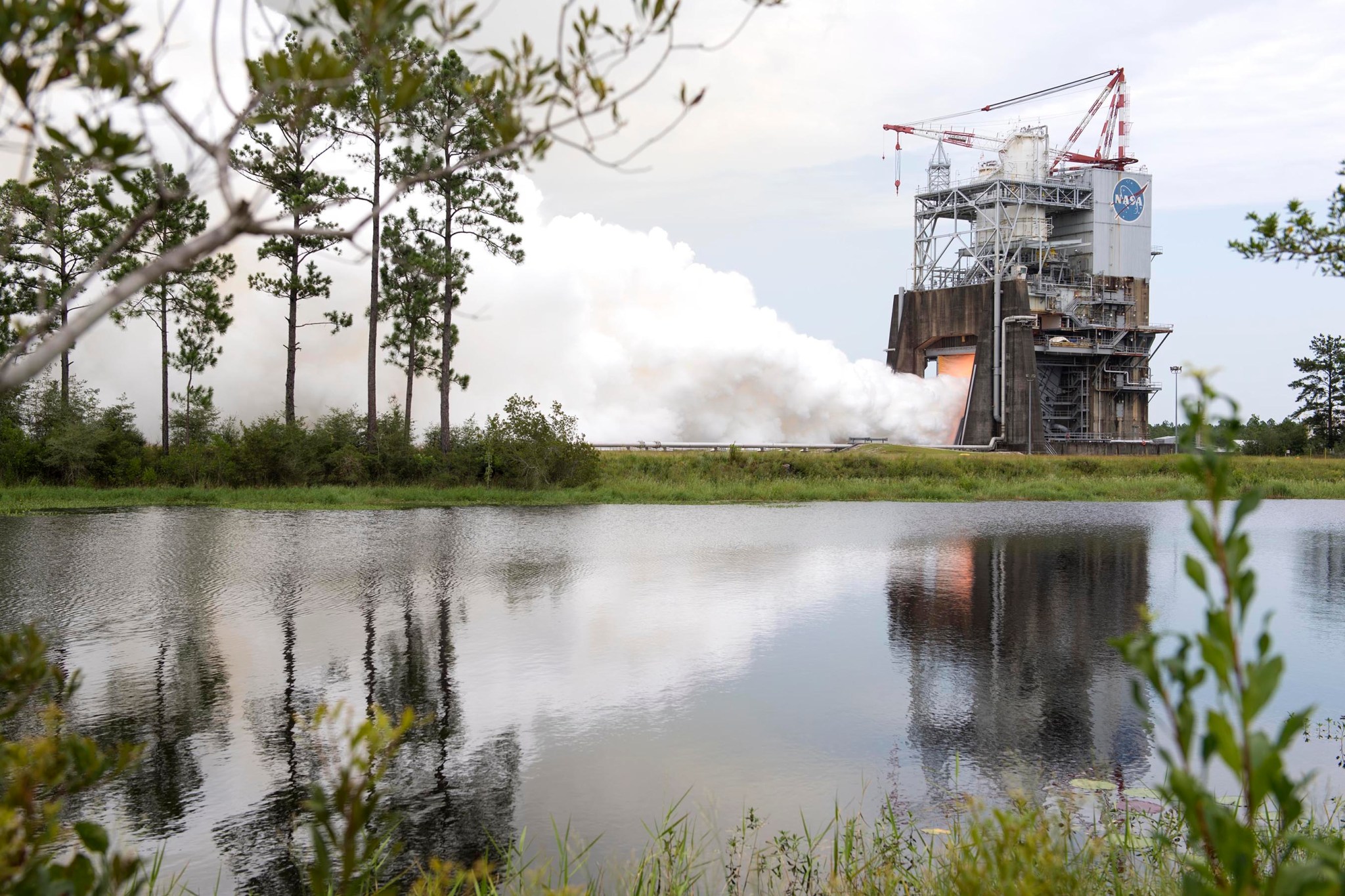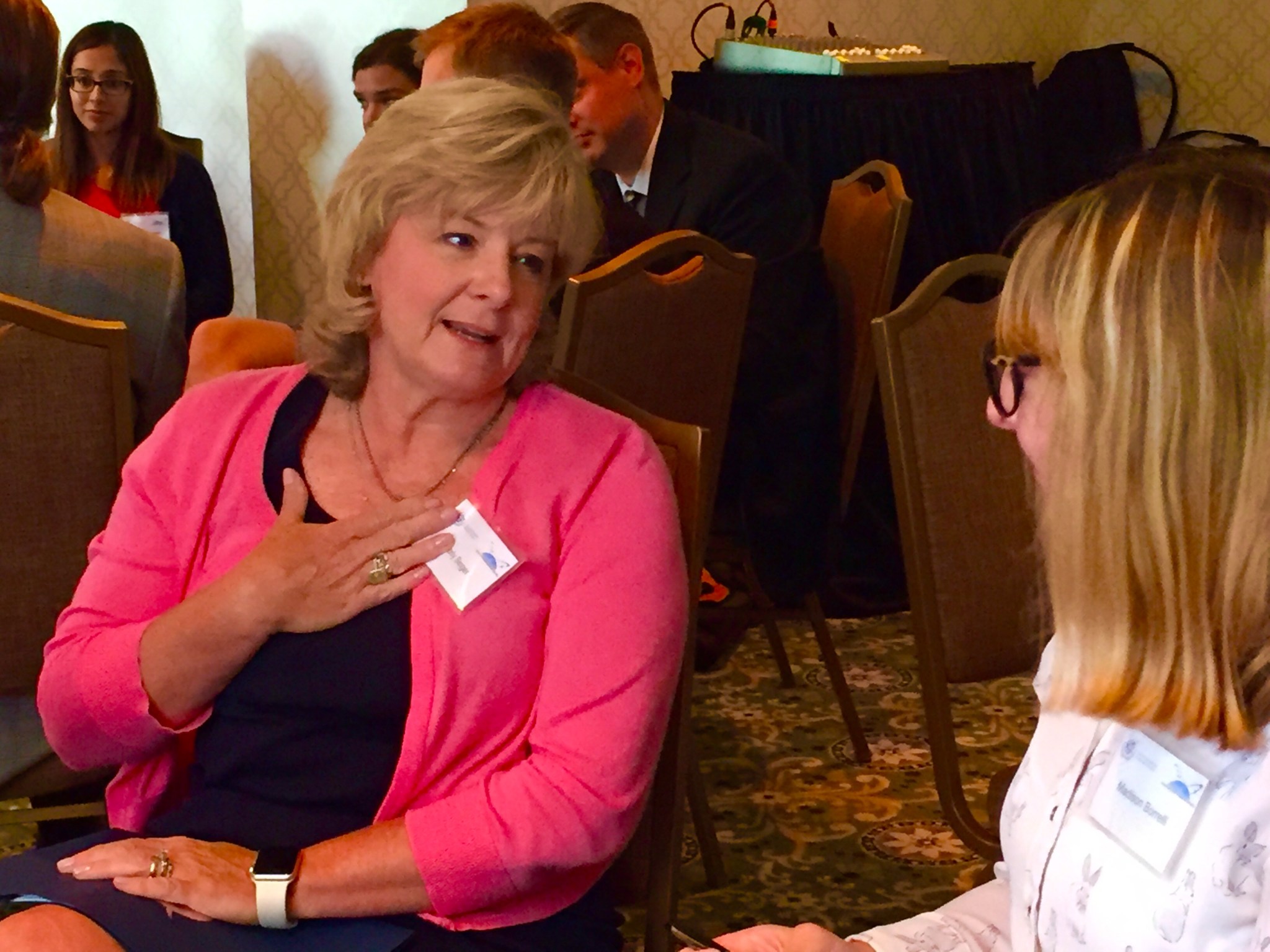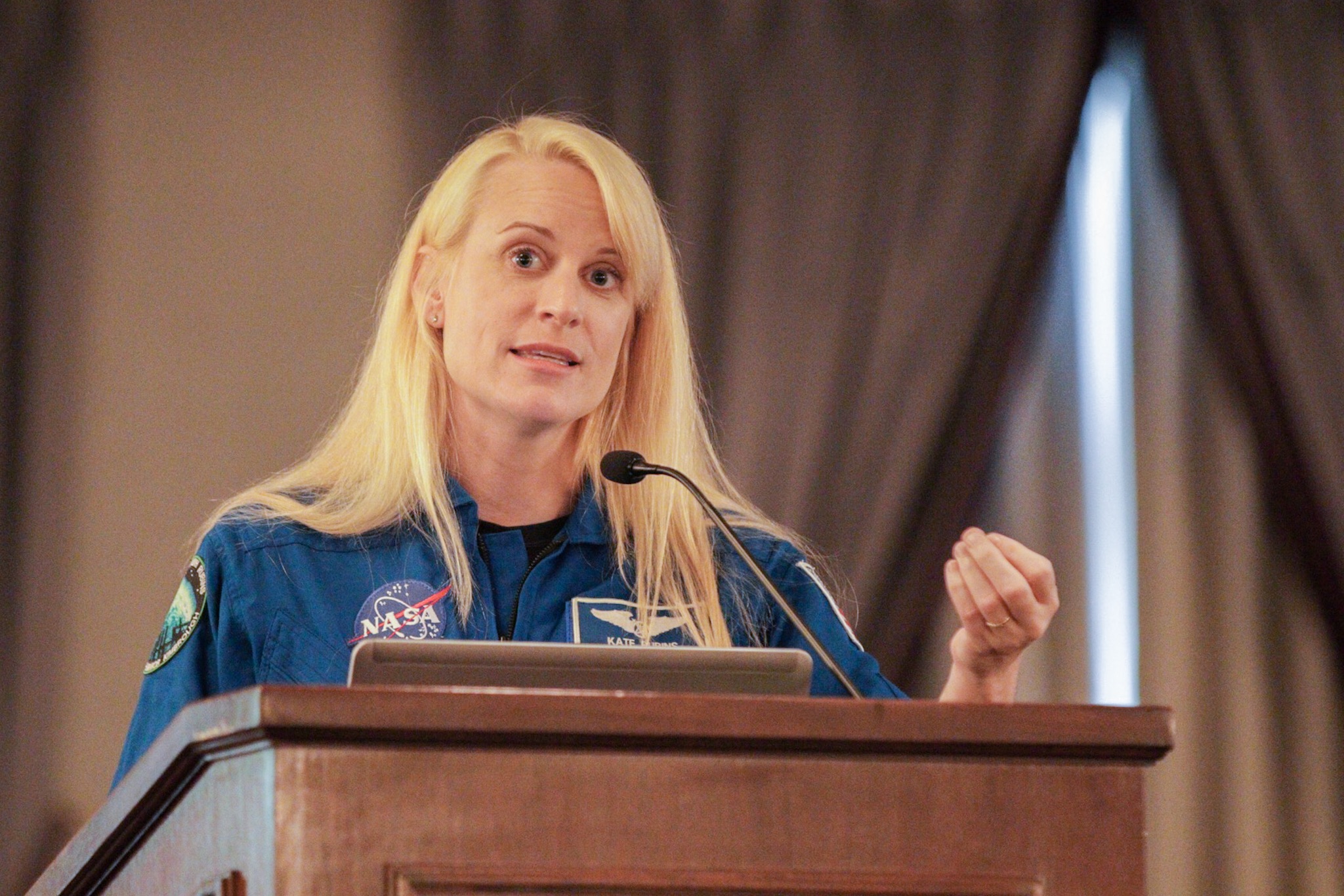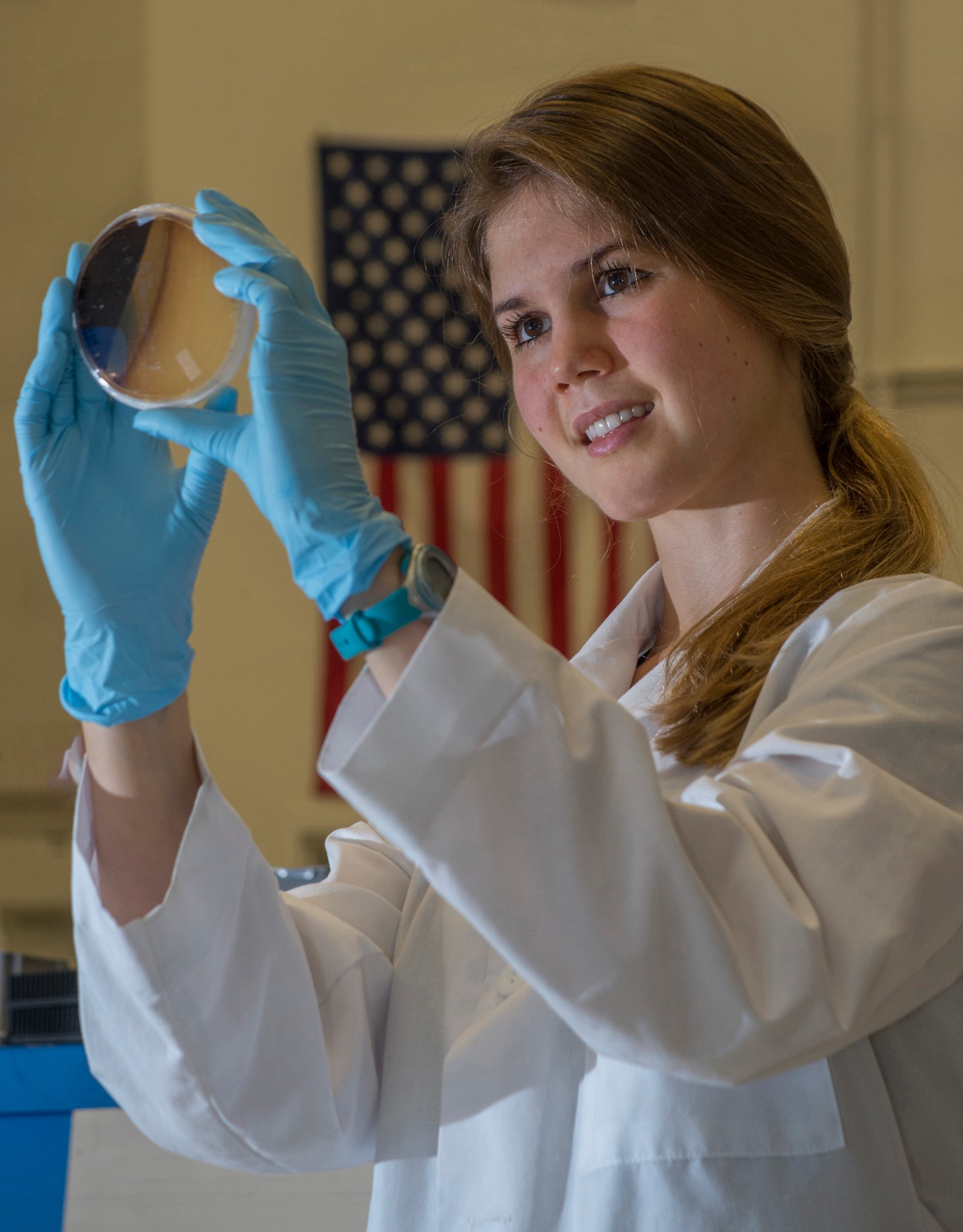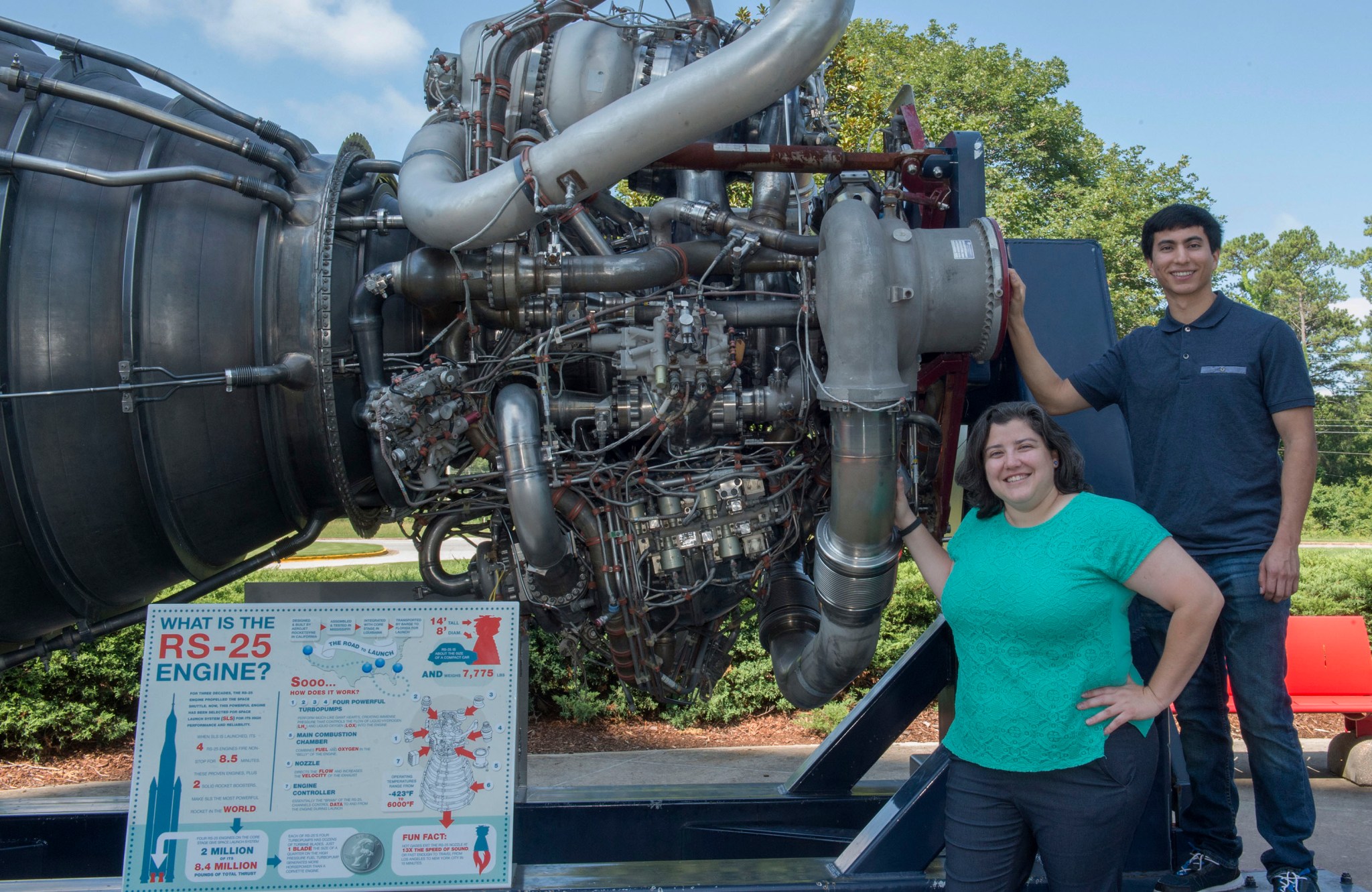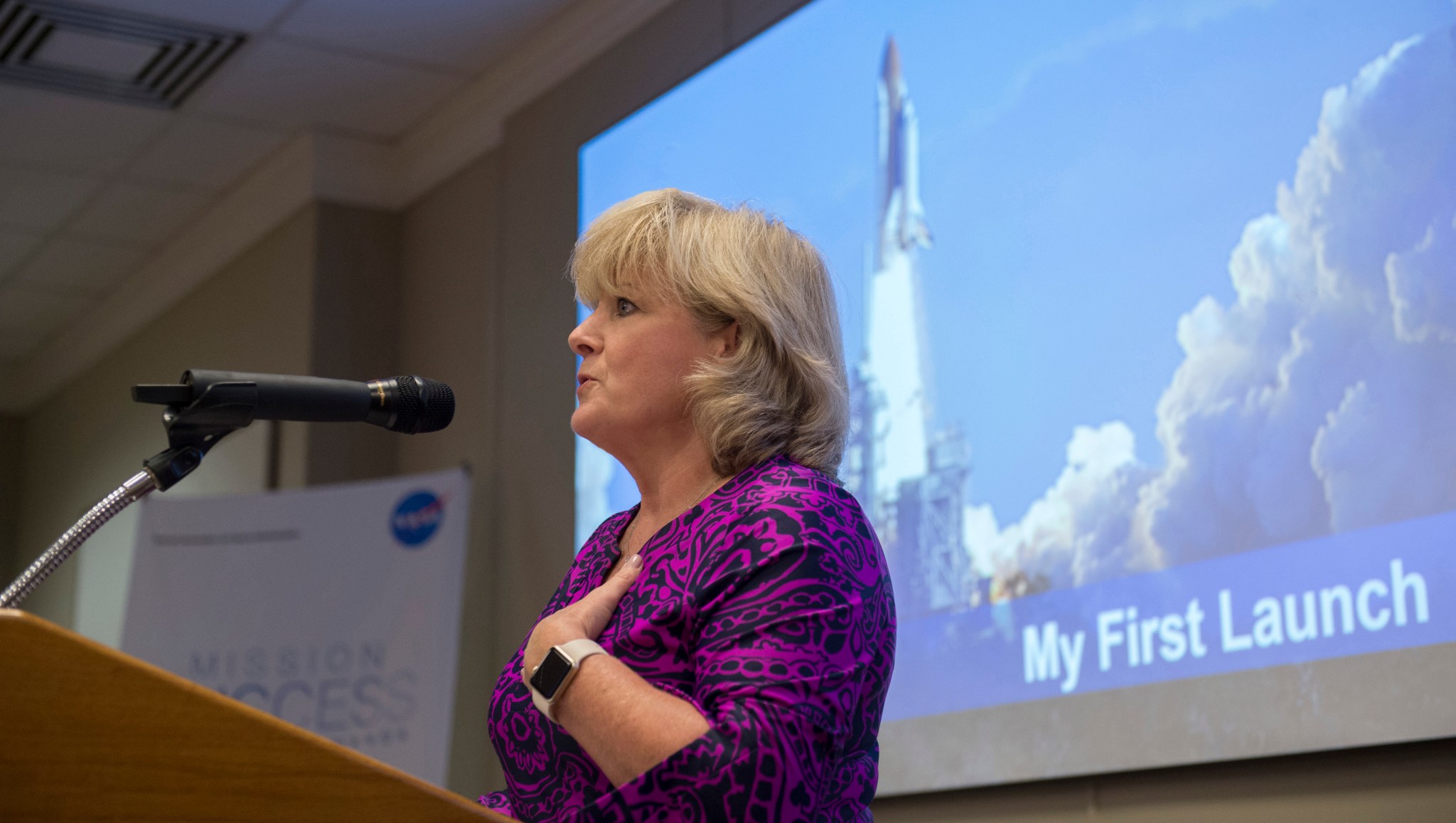In This Week’s Star
- Three Up, Three Down — NASA Tests RS-25 Flight Controller
- Marshall Managers, Science Investigations Featured at Annual Space Station Conference
- Marshall Tests Highly Accurate SLS Autonomous Navigation Unit
- Marshall Summer Interns Make a Real-World Impact
- Lawmakers Visit Marshall, View SLS Progress and Space Station Operations
- Marshall Director Speaks at National Association of Counties Conference
- Marshall Deputy Director Shares Experiences at July Forum
- Marshall’s Lori Sisk Awarded Golden Eagle Award at Shared Experiences Forum
- This Week in NASA History: Spacelab 2 Launches — July 29, 1985
- Obituaries
Three Up, Three Down — NASA Tests RS-25 Flight Controller
In the heart of baseball season, NASA completed its equivalent of a clean inning, successfully testing the third RS-25 flight controller for use on the new Space Launch System deep-space rocket. Engineers conducted a 500-second test of RS-25 Engine Controller Unit Number 5 on the A-1 Test Stand at NASA’s Stennis Space Center July 25. The test involved installing the controller unit on an RS-25 development engine and firing it in the same manner, and for the same length of time, as needed during launch.
With this latest test, NASA continues to set the stage for deep-space exploration missions, achieving another milestone toward launch of the first integrated flight of SLS and NASA’s Orion spacecraft, Exploration Mission-1. SLS will be powered at launch by four RS-25 engines, firing simultaneously to provide 2 million pounds of thrust, working in conjunction with a pair of solid rocket boosters to produce up to 8 million pounds of thrust.
The four RS-25 engines for the initial flight are former space shuttle main engines, modified to perform at a higher thrust level and with new controllers. The controller is the key modification to the engines and is characterized as the “brain” that provides precision control of engine operation and internal health diagnostics, and allows communication between the RS-25 engine and the SLS. During launch and flight, the controller communicates with the SLS flight computers, receiving critical commands and returning engine health and status data.
Early tests at Stennis provided critical data for development of the new controller by NASA, RS-25 prime contractor Aerojet Rocketdyne of Rancho Cordova, California, and subcontractor Honeywell Aerospace of Phoenix, Arizona. NASA tested the first flight controller on the A-1 Test Stand at Stennis in March. The second flight controller was tested in May. Following review of test data, both controllers were designated for use on RS-25 engines that will power the SLS launch. RS-25 tests at Stennis are conducted by a team of NASA, Aerojet Rocketdyne and Syncom Space Services of New Orleans, engineers and operators. Syncom Space Services is the prime contractor for Stennis facilities and operations.
Marshall Managers, Science Investigations Featured at Annual Space Station Conference
By Bill Hubscher
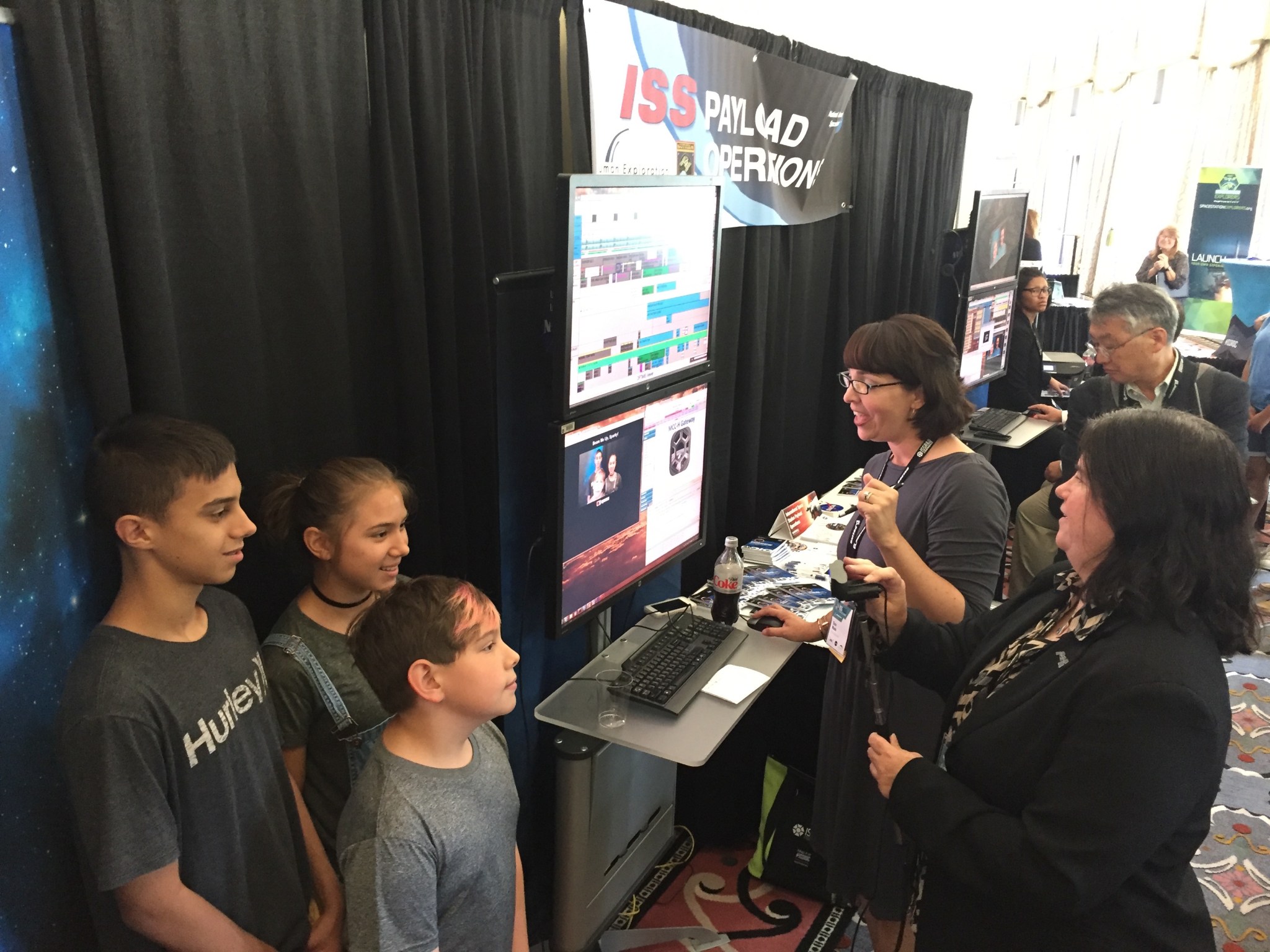
The sixth annual International Space Station Research & Development Conference was held in Washington, July 17-20 and NASA’s Marshall Space Flight Center was well-represented at the gathering of scientists, astronauts, researchers and team members who support the orbiting laboratory.
Marshall Deputy Director Jody Singer started the week with a group of NASA and space industry veterans, speaking with young people planning a future in space exploration. She served as one of a handful of mentors along with NASA Associate Administrator William Gerstenmaier.
“The space station is a blueprint for global cooperation and we want everyone, including you, to be a part of that,” Singer said. “It is a critical part of the next steps to deep space as crew members conduct research and test new technology that will help us move beyond our own orbit. It is also the proving ground for discoveries that will improve life on Earth.”
Bobby Watkins, director of Marshall’s Human Exploration Development & Operations Office, moderated a panel about the current and future platforms for conducting science experiments in space. As manager of the directorate with oversight of the Payload Operations Integration Center — the group of expert flight controllers guiding investigations on the space station, Watkins emphasized the important work being performed by the crew in space and the team on the ground.
“From the keynotes to the sessions to the networking opportunities, this year’s conference reached a new level of relevance for all who use the space station,” Watkins said. “For us at Marshall, it highlighted the vital role our payload operations team has played in research in orbit and how that role will expand with the commercialization of low-Earth orbit.”
Many members of the Marshall support teams were in attendance, meeting with payload developers to discuss the year’s successes and the future experiments destined for the space station. This included a demonstration of the Telescience Resource Kit payload.
When the station was in its planning stages nearly 20 years ago, a group of Marshall software developers created the resource kit, called TReK — a suite of programs for scientists and researchers that allows efficient communications with investigations in orbit and the ability to acquire data from the experiments straight from their home laboratories.
Jeff Lippincott, one of the Marshall TReK developers, showed conference attendees just how fast communications between their computer on the ground and the space station can be. Photos of conference attendees were sent to the space station and, moments later, a live video feed showed the same image on the payload’s computer screen on the station.
“It was great to connect with so many people who are currently using the station and our software,” Lippincott said. “We got a bit of feedback from them and showed future payload developers just how valuable these TReK tools can be.”
Other keynote speakers and presentations were made by NASA astronaut Kate Rubins, European Space Agency astronaut Samantha Cristoforetti, NASA Acting Administrator Robert Lightfoot and SpaceX CEO and lead designer Elon Musk. The conference was hosted by the American Astronautical Society and the Center for the Advancement of Science in Space, in cooperation with NASA. Videos of the various presentations and photos are posted at the conference website and on the conference’s Flickr page.
Hubscher, an ASRC Federal/Analytical Services employee, supports the Office of Strategic Analysis & Communications.
Marshall Tests Highly Accurate SLS Autonomous Navigation Unit
Here on Earth, we use global positioning systems to guide travelers through unfamiliar territory. But when astronauts venture out into deep space, a different set of tools will be needed.
To take explorers into deep space and ultimately to the surface of Mars, NASA is building its most powerful rocket, the Space Launch System. To meet the ambitious exploration goals of SLS, engineers at NASA’s Marshall Space Flight Center are testing an autonomous navigation system to ensure mission success.
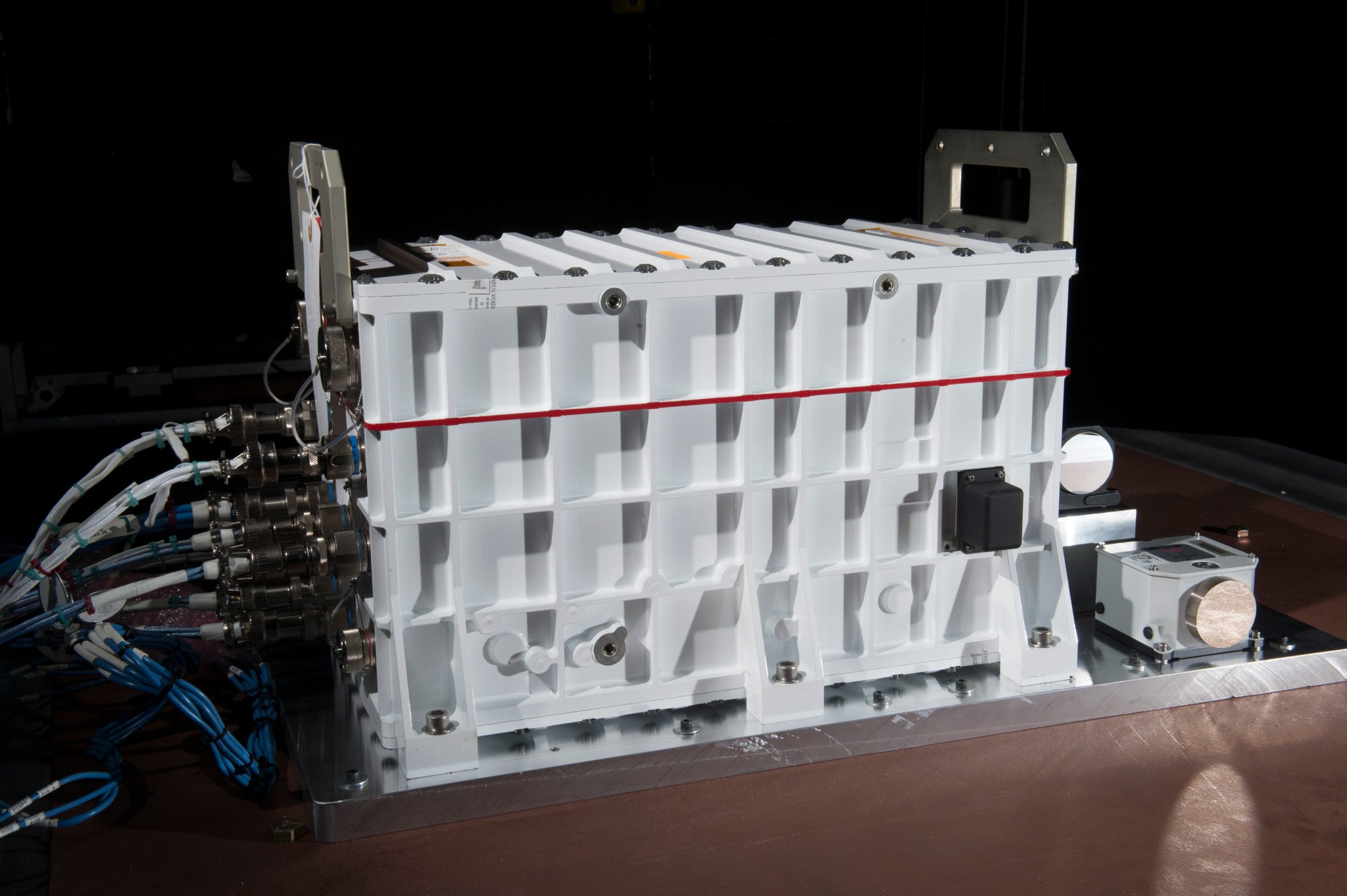
Space travel demands navigational accuracy and stability — essential for the SLS to drive people farther into space than any heavy-lift spacecraft has traveled. SLS will use an autonomous system to accurately guide the rocket through Earth’s atmosphere into deep space, eliminating the possibility of signal interference. Getting the SLS to these new heights and new frontiers requires inertial navigation technology with various system components that work together.
The Redundant Inertial Navigation Unit — an element of SLS’s Guidance Navigation and Control architecture, part of its integrated avionics — will pilot the spacefaring SLS from NASA’s Launchpad 39B at Kennedy Space Center in Florida, through extreme launch conditions to low-Earth orbit and onto the designated separation destination.
This navigation system tracks the launch vehicle’s blazing ascent using a host of motion-sensing accelerometers, rotation-sensing gyroscopes and internal computers that generate, process and relay vital information. Jay Campbell, the Redundant Inertial Navigation Unit lead engineer at Marshall, describes the system as “the most complex electronics box in the rocket’s core stage.”
Before launch, the RINU initially uses this intricate technology to determine how the rocket is oriented in reference to the North Pole through a process called gyrocompass alignment. Precise knowledge of the RINU’s orientation, with reference to the North Pole at launch, is critical to the rocket achieving the proper orbit during flight. Acceleration and rotation are then measured during flight to determine position, velocity and attitude of the launch vehicle.
“Understanding the rocket’s orientation during flight is critical to our ability to navigate the rocket to its intended orbit,” said Thomas Bryan, Marshall’s Space Systems Avionics team lead. “If the RINU was available for everyday use, we could receive turn-by-turn directions from Huntsville not just to Cocoa Beach, but to our favorite spot on the beach to watch SLS take off.”
Beginning in March 2017, avionics and guidance, navigation and control engineers at Marshall collected data from over 40 rigorous tests. During testing, the RINU was bolted on top of the vehicle simulation platform in Marshall’s impressive Six Degree-of-Freedom Laboratory. Each test presented the navigation device with a different wind profile to simulate the SLS motions in a launch pad environment. The six-legged platform duplicated the launch-pad-like movements at the top of SLS on the launch pad, ranging from mild, tree-like swaying, to off-balanced, washing-machine-spin-cycle-like yawing. At the end of each 90-minute test, the avionics team compared the unit’s self-determined attitude, with its actual, manually calculated attitude. Manual attitude measurement involves sighting the North Star (Polaris) to optically compare and calculate the orientation of the RINU.
That same Marshall laboratory contributed to the successful development of the International Space Station’s Common Berthing mechanism, the Hubble Space Telescope and the Lunar Roving Vehicle. This new test series demonstrated the functional readiness of the navigation unit, proving how the system finds its true north in various launch pad environments.
“To my knowledge, this is the first time that this type of test has been performed on this type of system,” said Emerson Oliver, SLS Navigation Lead with Dynamic Concepts Inc., supporting the SLS team. “To an engineer and a designer, test data is priceless, it validates years of modeling and analysis and confirms with high confidence that this system will perform as expected in flight.”
The SLS is designed for spacefaring to the unexplored. Successful functional testing confirms that when the SLS takes off, the RINU will be a key navigation component for guiding the SLS to new heights in human space exploration.
Marshall Summer Interns Make a Real-World Impact
By Amanda M. Adams
Morgan Sisk, a biomedical science intern at NASA’s Marshall Space Flight Center, is working to ensure we don’t contaminate Europa — one of Jupiter’s moons — with microbes from Earth during NASA’s potential Europa lander missions.
As a 19-year-old rising sophomore from Auburn University in Alabama, Sisk is one of over 200 students from varying disciplines who spent their summer working and learning at Marshall. These students aren’t out making office coffee runs; they are working hard to help NASA solve mission-critical problems.
“We’re talking about traveling to an extraterrestrial body to look for life,” said Sisk. “That within itself is so inspiring. To be able to be a part of this mission has been an invaluable experience for me and I am so grateful to be here.”
Aerospace engineering major Cristian Acosta, a senior from California State University Long Beach, is in his third internship at Marshall. He is designing propulsion systems for a potential lunar lander. “This is a very unique project because NASA is partnering with private industry to develop a robotic spacecraft to land on the moon using new chemical propellants,” said Acosta. “This has been a really positive experience for me because it’s allowed me to step out of my comfort zone and ask questions from experts in their field. The fact that they are actually using my work to redefine the capabilities of the lunar lander is really amazing to me.”
Former high school science teacher Jennifer Adams returned to college after seven years of teaching to pursue a degree in mechanical engineering from the University of North Carolina at Charlotte. “It was my students who encouraged me to go back to school,” said Adams. “They wanted me to work for NASA and even made a ‘Future NASA Employee’ name badge for my birthday.”
Now in her second summer with NASA, Adams is analyzing data on the RS-25 engine that will serve as the main propulsion for the Space Launch System core stage. She’s also working on a process to monitor 3-D printing to conserve resources by catching defects before and during printing. “It’s truly a dream come true story,” said Adams. “I remember the greats like former NASA astronaut Sally Ride and what she did for women and space, and now NASA astronaut Peggy Whitson and how she’s breaking all the time-in-space records for women on the International Space Station. As a science teacher, I always championed the STEM fields of science, technology, engineering and mathematics and now it’s neat to have this opportunity to contribute as well.”
To close their summer with Marshall, all interns are designing posters highlighting their NASA work experiences. They will display their posters Aug. 2, during the annual Intern Poster Expo, which will be held from 1-3:30 p.m. in the Activities Building 4316, followed by an awards ceremony at 4 p.m. Marshall and Redstone Arsenal team members are encouraged to attend the Poster Expo, view the student posters and speak with the interns about their work.
To learn more about application deadlines and internship opportunities at NASA centers, click here.
Adams, an ASRC Federal/Analytical Services employee, supports the Office of Strategic Analysis & Communications.
Lawmakers Visit Marshall, View SLS Progress and Space Station Operations
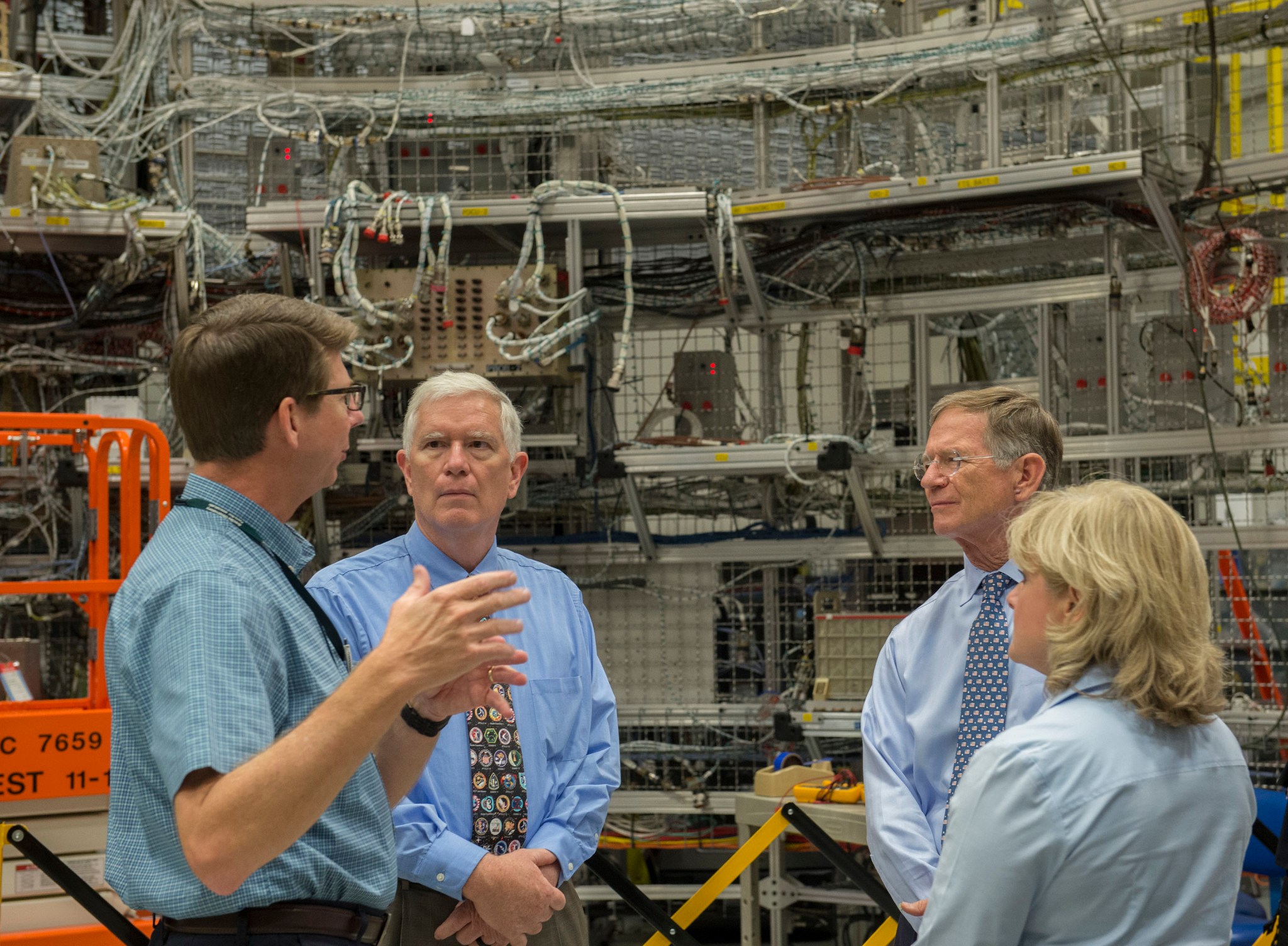
U.S. Rep. Mo Brooks, representing Alabama’s 5th Congressional District, second from left, and U.S. Rep. Lamar Smith, representing Texas’ 21st Congressional District, second from right, view progress on NASA’s Space Launch System July 21, during a tour of NASA’s Marshall Space Flight Center. It was the first visit to Marshall for Smith, chairman of the House Science Committee, on which Brooks also serves. Here, the congressmen discuss the agency’s new heavy lift rocket with Dan Mitchell, SLS Integrated Avionics and Software lead engineer, left, and Marshall Center Deputy Director Jody Singer, right, in Marshall’s Systems Integration Laboratory where the rocket’s various avionics components are being integrated. Brooks and Smith also toured the newly constructed SLS test stands and Marshall’s Payload Operations and Integration Center, “science central” for the International Space Station. (NASA/MSFC/Emmett Given)
Marshall Director Speaks at National Association of Counties Conference
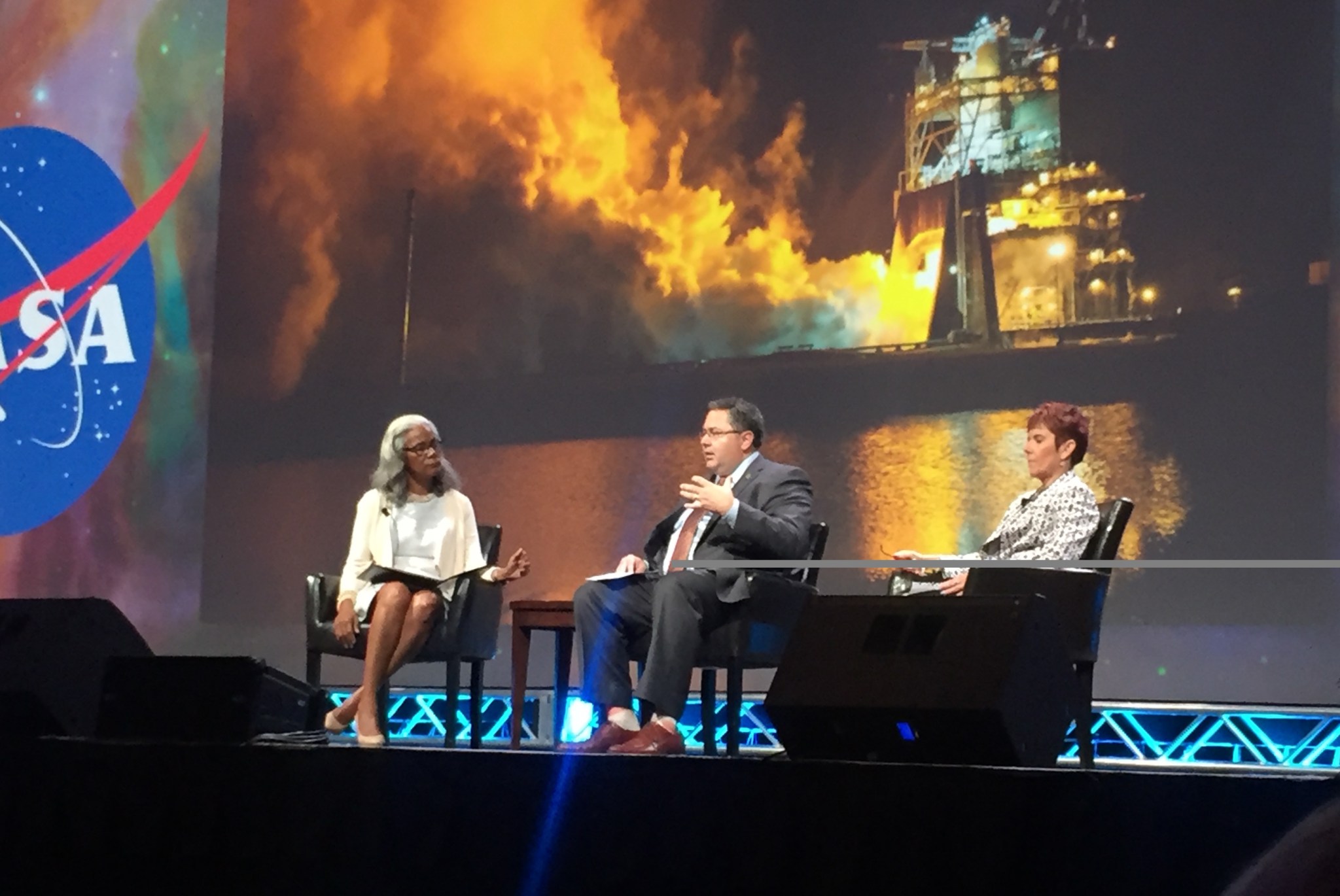
NASA’s Marshall Space Flight Center Director Todd May, center, and Marla Pérez-Davis, Glenn Research Center deputy center director, right, provide an update on NASA human exploration plans July 22 at the National Association of Counties Annual Conference & Exposition in Columbus, Ohio. Approximately 2,400 elected officials and county staff from across the country attended the conference. (NASA/MSFC)
Marshall Deputy Director Shares Experiences at July Forum
By Jonathan Deal
Before she was the deputy director of NASA’s Marshall Space Flight Center, Jody Singer worked in program and project areas that included space shuttle external tank, space shuttle main engine, reusable solid rocket boosters and the Space Launch System.
She shared her varied and wide career experiences July 20 to a packed room of Marshall employees at the Shared Experiences Forum. Singer’s talk was the 14th in the Shared Experiences Forum Series — part of Marshall’s Mission Success is in Our Hands initiative, sponsored by Marshall’s Safety & Mission Assurance Directorate. The initiative seeks to help team members make meaningful connections between their jobs and the safety and success of NASA missions and is made possible through a partnership between Marshall’s Safety & Mission Assurance Directorate and Jacobs Engineering.
As the first female project manager for reusable solid rocket boosters, Singer’s first launch as project manager was the STS-107 Columbia in 2003. She was responsible for giving the final “go” to the launch integration manager.
“It was really big for me, because not only was I the first female project manager in shuttle, but I had also never worked in reusable solid rocket boosters,” said Singer. “As I look back on my career and try to pay it forward, I see how important that really was. It was challenging — but also so rewarding.”
The STS-107 launch was the final flight of space shuttle Columbia. The crew and orbiter were lost during reentry, approximately 16-minutes prior to the scheduled touchdown at Kennedy Space Center.
“I can still remember being at home with my family with the TV on in disbelief,” said Singer. “At that point in time, everyone was trying to understand what was happening. It was a tragedy to lose our crew. It was also time to gather together and not look for blame, but to look for what we needed to understand where we were going and take care of our people.”
Singer spoke about the lessons learned from being part of the team that helped assess the root cause of the accident, NASA’s investigation and speaking to the Columbia Investigations Board.
“It was nerve-racking, but I always knew that I had the team with me and they had my back. And from that point on,” she said, “I realized it wasn’t about me having all the answers, it was about making sure the team was ready and they could help me and vice-versa. It was a sad day. But what I learned is how our team grew together as we worked our way to return to flight.”
Singer had advice for Marshall employees working on the SLS — the most powerful rocket ever built that will be capable of sending astronauts deeper into space than ever before, including to Mars: “Today, we are making history. You are going to be the ones that write the next chapter,” she said.
“Mission success is accomplished where everyone arrives home safely. There will be some days that you may think you are not making an impact. But keep in mind that no matter what job you are doing, you are making a difference not only to NASA, but to this nation, to this center and to your family.”
Deal, an ASRC Federal/Analytical Services employee and the Marshall Star editor, supports the Office of Strategic Analysis & Communications.
Marshall’s Lori Sisk Awarded Golden Eagle Award at Shared Experiences Forum
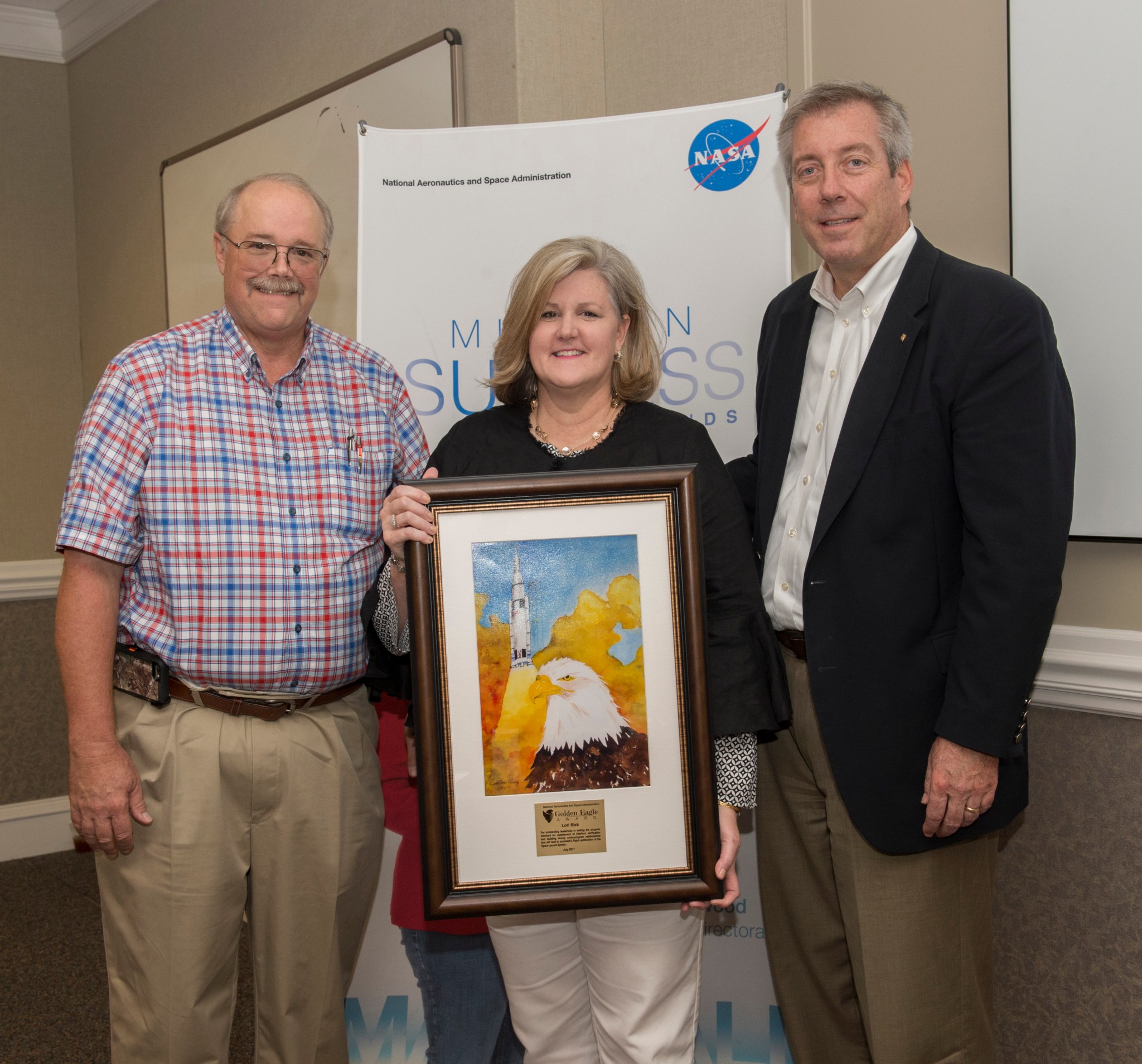
Lori Sisk, center, systems engineer for verification and validation in NASA Marshall Space Flight Center’s Spacecraft & Vehicle Systems Department, receives the Golden Eagle award from Rick Burt, left, head of Marshall’s Safety & Mission Assurance Directorate, and Jeff Haars, ESSSA deputy general manager of Jacobs in Huntsville. Sisk received the award for outstanding leadership in support of mission success. “Lori guided the verification planning and joint assessments between the Space Launch System Program and the Ground Systems Development Program,” said Burt. “Her leadership, hard work, dedication and influence across organizational boundaries set the program standard for assessment of interface verification.” (NASA/MSFC/Emmett Given)
This Week in NASA History: Spacelab 2 Launches — July 29, 1985
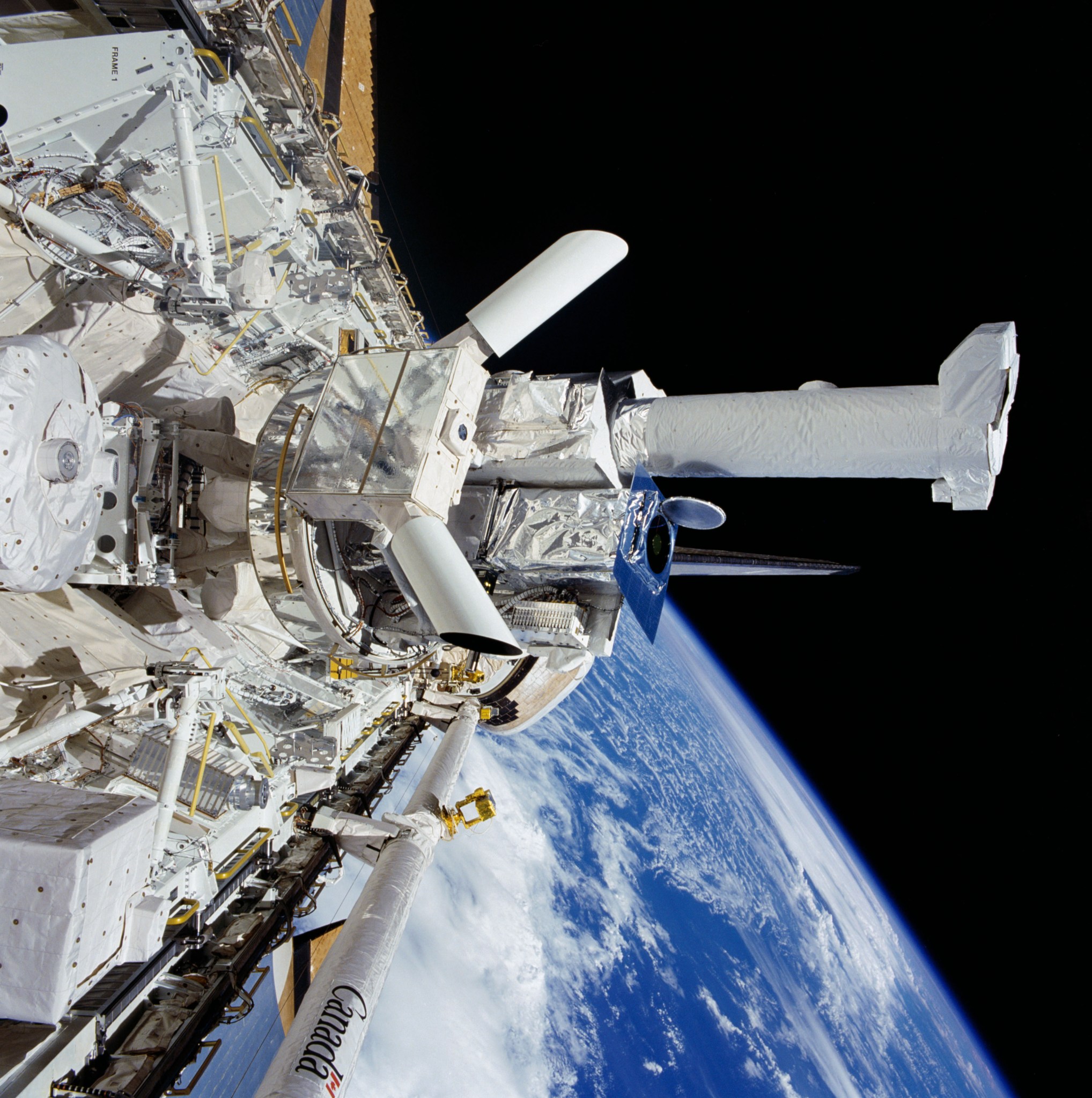
This week in 1985, space shuttle Challenger and STS-51F launched from NASA’s Kennedy Space Center. STS-51F carried the Spacelab 2 module — a payload that contained scientific instruments dedicated to life sciences, plasma physics, astronomy, high-energy astrophysics, solar physics, atmospheric physics and technology research. Here, the Solar Optical Universal Polarimeter experiment is visible among the cluster of Spacelab 2 hardware in the orbiter’s cargo bay. Today, the Payload Operations Integration Center at Marshall serves as “science central” for the International Space Station, working 24/7, 365 days a year in support of the orbiting laboratory’s scientific experiments. The NASA History Program is responsible for generating, disseminating, and preserving NASA’s remarkable history and providing a comprehensive understanding of the institutional, cultural, social, political, economic, technological, and scientific aspects of NASA’s activities in aeronautics and space. For more pictures like this one and to connect to NASA’s history, visit the Marshall History Program’s webpage. (NASA)
Obituaries
Boyce C. Brown, 83, of North Little Rock, Arkansas, died May 27. He retired from the Marshall Center in 1994 as a data systems engineer. He is survived by his wife, Patsy L. Brown.
Lonia R. Moore, 69, of New Market, Alabama, died July 20. She retired from the Marshall Center in 2005 as a paralegal specialist. She is survived by her husband, Billy D. Moore.



























